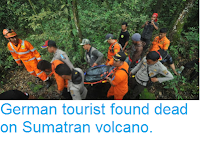The Darwin Volcanic Ash Advisory Centre has reported an eruption on Mount Karinici, Sumatra, that produced an ash column 4.3 km high on Sunday 13 August 2017. This column persisted for several days, having drifted only 30 km to the southwest by Thursday 17 August. Mount Karinici, which is located in the Karinici Sablat National Park, on the border between West Sumatra and Jambi Provinces, is the highest volcano in both Sumatra and Indonesia, and one of the most active, typically undergoing several eruptions in the course of a year. However most of these eruptions are quite small; the volcano is not considered to be particularly dangerous, and is a popular tourist attraction.
The location of Mount Karinici, Sumatra. Google Maps.
The
Indo-Australian Plate, which underlies the Indian Ocean to the west of
Sumatra, is being subducted beneath the Sunda Plate, a breakaway part of
the Eurasian Plate which underlies Sumatra and neighbouring Java, along
the Sunda Trench, passing under Sumatra, where friction between the two
plates can cause Earthquakes. As the Indo-Australian Plate sinks further
into the Earth it is partially melted and some of the melted material
rises through the overlying Sunda Plate as magma, fuelling the volcanoes
of Sumatra.
The Subduction zone beneath Sumatra. NASA/Earth Observatory.
The two plates are not directly impacting one-another, as occurs in the subduction zones along
the western margins of North and South America, but at a steeply
oblique angle. This means that as well as the subduction of the
Indo-Australian plate beneath the Sunda, the two plates are also moving
past one-another. This causes rifting within the plates, as parts of
each plate become stuck to the other, and are dragged along in the
opposing plate's direction. The most obvious example of this is the
Sumatran Fault, which runs the length of Sumatra, with the two halves of
the island moving independently of one-another. This fault is the cause
of most of the quakes on the island, and most of the island's volcanoes
lie on it.
The movement of the tectonic plates around Sumatra. NASA/Earth Observatory.
See also...
Follow Sciency Thoughts on Facebook.









